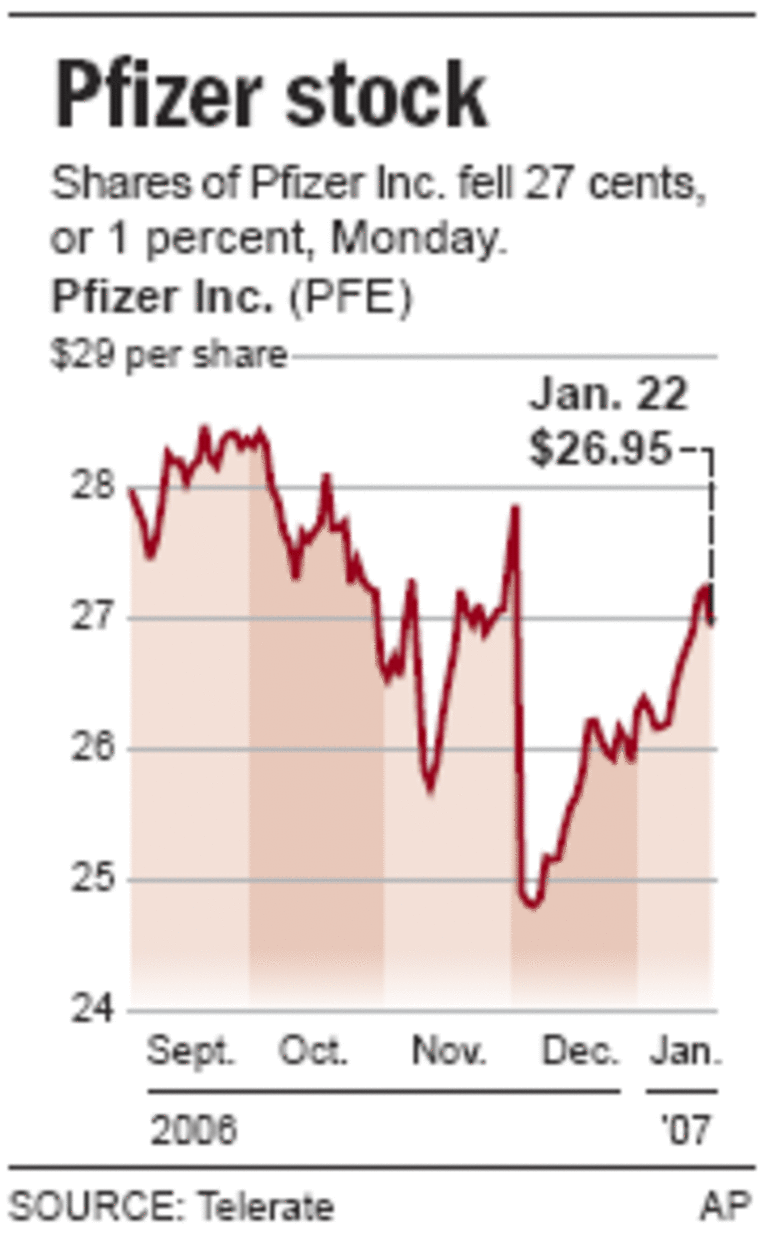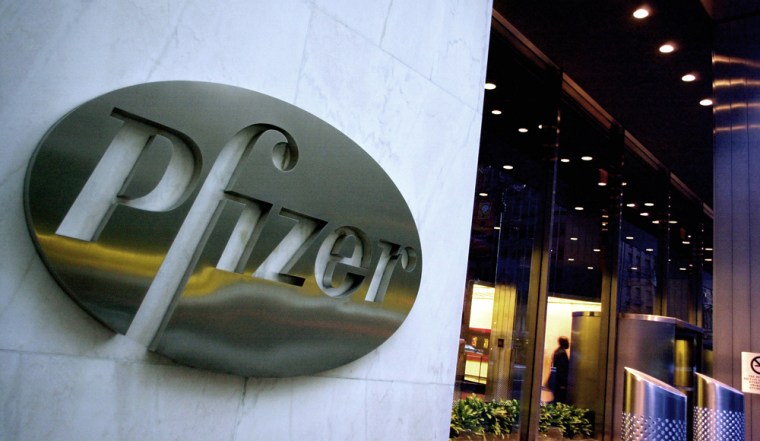Pfizer Inc., struggling with fierce competition from makers of generic drugs, announced Monday it will cut 10,000 jobs and close at least five facilities as part of an effort to slash its annual costs by up to $2 billion by the end of next year.
The drastic measures by the world’s largest drug maker highlight the challenges faced by many pharmaceutical companies recently. In addition to patent expirations, big drug companies are facing a business climate where insurers and other large purchasers of medicines are demanding lower prices and more evidence of products’ worth.
Although big rounds of job cuts typically boost a company’s stock prize, shares of Pfizer fell 27 cents, or 1 percent, to close Monday at $26.95 on the New York Stock Exchange.
It’s the second time in two years the maker of Viagra and Lipitor has announced a major cost-reduction plan to combat the loss of about $14 billion in revenue this year due to expiring patents. The company is at risk of losing 41 percent of its sales to generic competition between 2010 and 2012, according to Prudential analyst Tim Anderson.
The latest cuts, forecast to save $1.5 billion to $2 billion, come on top of a previously announced plan to cut costs by $4 billion a year by 2008. The 10,000 layoffs amount to about 10 percent of the company’s global work force and include the elimination of 2,200 jobs from the U.S. sales force, which Pfizer announced late last year. The company said Monday it would cut 20 percent of its European sales force but didn’t say how many jobs that will be.
Pfizer will close three research sites in Michigan and two manufacturing plants in New York and Nebraska. It may also sell another manufacturing site in Germany and close research sites in Japan and France.
Pfizer also will restructure its U.S. commercial business into five distinct units, each with a general manager responsible for that group’s performance. It will also drop two areas of research and consolidate its development efforts.
“I believe we must transform the way we’ve done business in the past in order to be more successful in the future,” said Jeffrey Kindler, who became Pfizer’s chief executive last summer and chairman last month. “Incremental evolution is not enough. Fundamental change is imperative — and it must happen now.”
Pfizer reiterated that its revenue would be flat this year and next, but said it expects earnings to jump by 6 percent to 9 percent in both 2007 and 2008.
Analysts are skeptical Pfizer’s current and pipeline drugs can generate enough sales to compensate for revenue it stands to lose. Still, Pfizer reiterated it will introduce six new products a year beginning in 2011, four from its own research and two from collaborations or acquisitions.

Pressure on Pfizer has intensified since safety issues forced it to halt development of the star drug in its pipeline, which was slated to replace the best-selling Lipitor as it loses patent protection as early as 2010.
Antidepressant Zoloft lost patent protection last year and its sales sank 79 percent to $166 million during the fourth quarter. This year, Pfizer will face generic competition on blood-pressure medicine Norvasc, which brought in $4.9 billion in sales last year, and allergy treatment Zyrtec, with $1.6 billion in revenue in 2006.
Kindler acknowledged that the company couldn’t cut its way to growth.
Still, the cuts do help shore up business and remain a good short-term strategy as the company seeks acquisitions to boost revenue, said Barbara Ryan, an analyst at Deutsche Bank.
The sites in Michigan employ about 2,300 people, while the plant being closed in the Brooklyn borough of New York employs 600 people. Only 25 jobs will be lost in Nebraska. Pfizer said many of the Michigan workers will be offered jobs elsewhere in the company.
Pfizer’s fourth-quarter earnings report, issued earlier Monday, illustrated the company’s woes. Net income for the period rose sharply because of the $16.6 billion sale of its consumer health care business last month, resulting in an after-tax gain of $7.9 billion. However, after adjusting for that gain and other items, Pfizer’s earnings fell 15 percent on flat sales.
U.S. sales of Lipitor, Pfizer’s top-selling drug, slipped 6 percent to $1.95 billion. Last summer Zocor, a rival cholesterol treatment made by Merck & Co., lost patent protection and insurers have pushed the cheaper versions of that drug over Lipitor when appropriate.
Ian Read, president of Pfizer’s Worldwide Pharmaceutical Operations, predicted modest revenue growth for Lipitor this year as the company’s sales representatives aggressively point out its advantages over its competitors. Lipitor revenue for the year rose 6 percent to $12.89 billion.
As insurers and the government pressure pharmaceutical companies to keep prices down and refuse to pay for some new treatments, drug makers are taking bigger risks to find new types of medicines. But their attempts can fail. Last year, safety issues forced Pfizer to scrap its drug torcetrapib, a novel cholesterol treatment, after spending $800 million developing it.
Pfizer’s own labs haven’t been very productive, and the company hasn’t introduced a blockbuster since it discovered Viagra in 1998.
Dr. John LaMattina, president of Pfizer Global Research and Development, said he wasn’t satisfied with the company’s development performance. To improve its success, he said Pfizer would end discovery efforts in dermatology and gastroenterology because the funds could be better used elsewhere.
LaMattina said the company would also centralize research efforts so work on any one disease is handled at one location. For example, in the past Pfizer conducted cancer research at six different sites, which LaMattina said only increased costs without improving productivity.
Vice chairman David Shedlarz said he knew analysts wanted more details on its development and acquisition strategy but said it wouldn’t help to be especially forthcoming.
“The more specific, the more the price of the deal goes up,” Shedlarz said.
For the fourth quarter, Pfizer’s net income soared to $9.45 billion, or $1.32 per share, from $2.73 billion, or 37 cents per share, a year ago. Excluding the gain from the sale of the consumer division, earnings totaled $3.05 billion, or 43 cents per share, down from an adjusted $3.59 billion, or 49 cents a share, a year ago. The earnings beat the consensus estimate of analysts surveyed by Thomson Financial by a penny per share.
Revenue was essentially flat at $12.60 billion, compared with $12.55 billion a year ago. Analysts expected sales of $12.62 billion.
